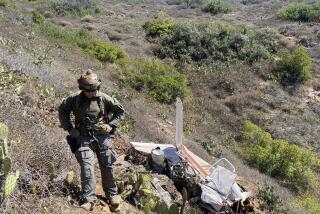Rock for Sale; Ocean Views
- Share via
A romantic -- or a Realtor -- might call it a lush isle in a Catalina cove, teeming with rare flora, surrounded by seaweed forests in the turquoise Pacific.
And for the first time since four guys bought it from the U.S. government some 70 years ago, the archipelago is for sale by its current owners, who inherited it. Asking price: $2.75 million.
The upside: gorgeous solitude and the novelty of owning a private island. The downside: no utilities, uncertain development potential and the nickname Bird Rock for good stinky reason.
Yet USC and UCLA have expressed interest in this 1.3-acre property for its laboratory of sea life, says one of the real estate agents advertising this “private island paradise” about 24 miles from San Pedro.
And four or five serious prospects have called in the two months the island’s been on the market, according to Bud Mauro, who shares the listing with another agent at Paramount Rodeo Realty in Porter Ranch.
“Some offshore investors are interested, and some callers who are Korean. I guess it’s a big status symbol to own an island,” Mauro said.
Despite its bird-doo crust and uninhabitable appearance, its zoning that doesn’t rule out building but would require a permit that seems far-fetched for approval given that teeming reef, Mauro spoke with the optimism particular to those selling real estate in a seller’s market.
“It would absolutely make a fabulous yacht club,” he said of the island, whose shape could make it tricky to land most boats. “There could be floating docks where boats can tie up, and as far as power, that’s what generators are for, and they have all kinds of septic systems these days.... “
Speaking of which, he added, “You aren’t going to call it bird poop island are you?”
White Rock, its name on tax documents and what he prefers to call the only island he’s listed in a 30-year career, sits about 500 yards off the edge of Santa Catalina Island’s less populated Two Harbors community, which faces the mainland.
It is low-slung and home to malva rosa, a rare plant that was eaten off Catalina by the goat population.
And its lore is as rich as its guano, Michael and Ann Caffey of Glendale, who inherited the island, said this week.
Michael Caffey, who directed such prime-time TV shows as “McGyver,” “T.J. Hooker” and “Trapper John, M.D,” said he can appreciate the serendipitous quality of how his father came to own the island.
Sometime in the late 1920s, while motorcycling around for potential billboard locations for his then-employer, Benjamin Franklin Caffey met three men who later became his partners in the $140 purchase from the federal government.
“They were going to sell shares and build a casino,” Michael Caffey, 73, says with amusement.
It was not a bad plan, given the unfettered times. No zoning laws applied. The Hollywood crowd frolicked in the secluded coves around Two Harbors and gambling boats plied the coast.
But William Wrigley, who owned much of Catalina, gummed things up. He believed the rock was his and sued.
Three costly years later, Michael Caffey said, the partners won in court. But the Great Depression, and then World War II would freeze all their grand schemes. Eventually, three of the partners moved off the West Coast or died, their plans long abandoned.
Frank Caffey, who would head production at Paramount Studios in the business where dreams came true, clung to his majority ownership in the island. When he died, it was his only property, his son said.
By the 1980s, Michael Caffey and his family, which included 13 children, bought out the remaining partner’s heirs for $1,000. It was around this time that they paid the first visit they can remember, he said. They went again a few years ago, but only at the request of public TV host Huell Howser who did a segment on it.
The island had appeared in its share of movies, including the original “Mutiny on the Bounty” with Charles Laughton, Mauro said.
It has some little-known steps that Michael Caffey was always told were carved out hundreds of years ago by pirates known to hide their loot around Catalina.
And it has a treasure of marine life explored by researchers and students at the USC Wrigley Institute for Environmental Studies, which is tucked into the hill above the scattered buildings of Two Harbors.
Selling the island wouldn’t make the Caffeys rich. But their 12 surviving children couldn’t agree on what they would do with their piece of the rock, were it even practical to divide.
“Owning an island wasn’t their dream, or mine,” Caffey said. “But I think it might be somebody’s dream.”
More to Read
Inside the business of entertainment
The Wide Shot brings you news, analysis and insights on everything from streaming wars to production — and what it all means for the future.
You may occasionally receive promotional content from the Los Angeles Times.










